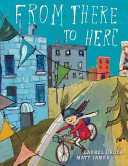2018 School Spending Survey Report
From There to Here
illus. by Matt James. 36p. Groundwood/House of Anansi. May 2014. Tr $18.95. ISBN 9781554983650.
COPY ISBN
In I Know Here, the narrator knows she and her family will soon be leaving their Saskatchewan home for the city, and in this sequel, so they do. The palette of the Toronto scenes is predominately blue-sky sunny, reflecting the story's ultimate optimism (events include finding a friend), although the wild dark colors of the forest continue their hold on the girl's memories.
In the Boston Globe-Horn Book Award-winning I Know Here (rev. 5/10), the young narrator knows she and her family will soon be leaving their home in the glorious wilderness of Saskatchewan, and in this sequel, so they do. The Toronto of the book's era (early 1960s) might look positively quaint to us, but to the girl it is completely exotic. "There" she lived on a gravel road without a name; "Here" she lives on the well-paved Birch Street. "There": the aurora borealis; "Here": "street lamps in a straight row." But just when you think the book is a paean to the forest primeval, in comes new neighbor Anne, "eight, almost nine" just like the girl, who back in the bush had no friend her own age. The palette of the Toronto scenes is predominately blue-sky sunny, reflecting the story's ultimate optimism, although the wild dark colors of the forest continue their hold on the girl's memories and in James's paintings, where images of moose and pine trees rest matter-of-factly within the confines of the girl's new house on Birch Street (birchless, by the way). While the bike helmets on Anne and our girl are more than a touch anachronistic, we know that the ride begun at the close of the book promises both amity and adventure. roger sutton
ALREADY A SUBSCRIBER? LOG IN
We are currently offering this content for free. Sign up now to activate your personal profile, where you can save articles for future viewing





Be the first reader to comment.
Comment Policy:
Comment should not be empty !!!